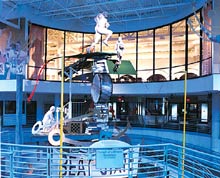NISMEC is the Northern Indiana hub for
I-STEM, the Statewide Science, Technology,
Engineering and Mathematics network established at the beginning of 2008 - see our issue 3.2 for a brief history and update on the two organizations.
The University of Notre Dame and Saint Mary's College have been responsible for running the NISMEC hub.
Professors Joseph J. Bellina of Saint Mary's College and Gordon Berry of Notre Dame have dual tasks as members of the 11 member I-STEM Coordinating Committee,
and as the directors of the NISMEC I-STEM hub.
In August 2009, we hired Beth Marchant, previously the Director of the Quarknet program
(see below for a more detailed bio), as our Operations Director. Her previous experinece, both as a science teacher at South Bend's LaSalle High School, and for
her work with the nationwide Quarknet program, promises to enable NISMEC to extend our program to the areas of greatest needs in the schools and in the community.
We receive I-STEM funding which comes from the Governor's office and a collaboration of Indiana biotech industry businesses, spearheaded by the Lilly Foundation to help us enhance all forms of STEM education in the schools and in the community.
These past two summers, we have used this support to develop an expanded set of Teacher Professional Development Programs for the South Bend, Mishawaka and Penn-Harris Madison schools,
for all K-12 grade teachers (see below for some of the details about the many successful 2009 summer workshops).
We are planning a continuing completemnt of professional development program this coming year.
It is an exciting period in the development of STEM education both statewide and locally: The I_STEM network is working closely with the Indiana Department of Edcuation, as well as with the Governor and the Legislature, and
with financial support from the biotech industry around the state: the goals of this initiative are strongly in-line with the NISMEC "Guided Inquiry is our Focus"
goal - hence, it is providing opportunities to bring research-based learning modules into the classrooms at all levels (P-16).
Our NISMEC group includes many community partners - for example, The Memorial Hospital Foundation; The other higher education institutions of St. Joseph County now play important roles in developing the
NISMEC programs: for example, the IUSB Department of Education with Dean Michael Horvath,
the Ivy Tech Bioechnology Department with George Twaddle, and the Ivy Tech Education Department with Linda Taylor, have begun to play important roles.
NISMEC's work is likely to be strengthened through the increasing coordination
between the County's Higher Education Organizations, our technological and manufacturing companies, and the county's three major school corporations in
coordinating solutions to our STEM needs and understandings.
STEM education is likely to play a role at the new KROC center (to be built at Chapin/Western Avenue intersection),
and several other joint Community STEM initiatives are underway (as mentioned above).
The coming year of 2010 promises to be an exciting time for the progress of science learning in St. Joseph County.
|



























